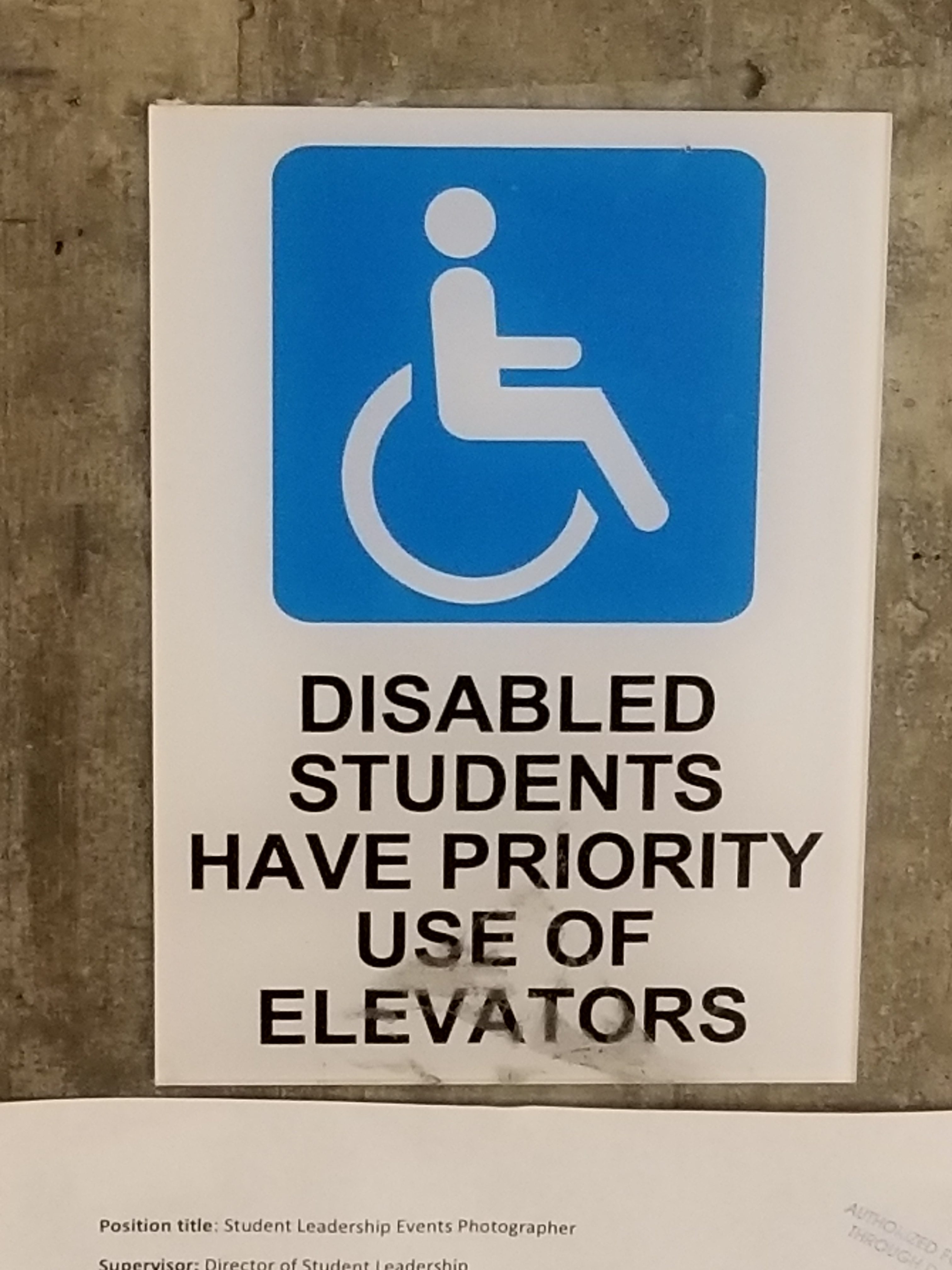
Elevating the Norm
Written by Joel Raphael, 10/22/2018
So, a new year, a new batch of students who don’t know basic elevator etiquette. I went over this a little in a previous op-ed, but my observations in the first few weeks of the quarter leads me to write about this topic again. You all don’t seem to realize what the purpose of the elevators are.
The elevators are not for able-bodied students.
This doesn’t mean that if you are able-bodied, you can’t use them, but it does mean that you do not have priority. They were not made for you; your conveyance is not their purpose.
We have a fairly robust population of students with various different transportation needs that require use of the elevators to access their classes. These students, and these students alone, are the target demographic of service for our elevators. That any able-bodied person may use them is a perk, not their intended design.
I will occasionally use the elevator, even though I am a conventionally able-bodied student. However, I only ever use it to go from the first floor of the BE building to the fourth, which would otherwise be six flights of stairs, and at the end of a day where I do use the stairs to go from floor to floor to floor… I get tired. I may be able bodied, but I am a bit older than most of you.
Most of you are in the prime of your life, in the best physical shape you will ever be, and yet, I see you pile on to the elevator car in droves to go from the first floor to the second.
The second floor isn’t even a real floor! It’s just the porch in front of the library! It’s a single flight of stairs! Why are you using the elevator to get there? There’s a staircase right next to the main elevators that leads right up there!
No able-bodied person should be reaching the library via elevator. Period.
I often hear complaints about how slow the elevators are from students. Those same students will then stuff the elevator as full as a sardine can, and then proceed to press the buttons on every floor, as opposed to only using it to travel several floors at a time. The elevator, then heaving with all of its mechanical might, far in excess of its design parameters (you know how scary the north elevators seem?), will then lumberingly carry its contents up a single floor, just to have a quarter of its passengers disembark.
The elevators are not for able-bodied students.
You want to know why the elevators are so slow? Because it’s stopping unnecessarily at every single floor so that a gaggle of able-bodied young people can keep from going up a measly 20 steps. In fact, as I write this, the south elevators have gone on the fritz, likely due to a mix of overuse, and being over weight-loaded.
This has real consequences, as the students who cause these problems generally are not the ones most affected by their occurrence. The able-bodied students, who likely never should have been using the elevators in the first place, are now slightly inconvenienced in that they may have to actually engage a gluteal muscle to reach the library. For our students for whom mobility is an issue, though, they are screwed. They have to find another bank of elevators to get to where they’re going. Keeping in mind, for instance, that neither the south nor the north elevators stop at the second floor. If the main elevator bank goes out… that’s it, they cannot reach the library, or indeed, any classroom off the first floor. They have no plan B. Everyone else can use the stairs that are just to the left of those elevators, or the other set of stairs just north of the elevators, or the other set of stairs directly in front of the library itself… but for people of limited mobility, they are stuck.
I think a good rule for able-bodied people to go by for using the elevator is that you should only use the elevator when traveling at least two stories. Keeping in mind that there is no second floor for most of the building, that means that if you’re on the first floor, you should only use the elevator if you are traveling between either the basement or first and either the fourth or fifth floor. If you are not going that far, use the damn stairs. It won’t kill you, and you could probably use the exercise. As far as you are concerned the “2” and “3” buttons don’t exist.
Now, a totally separate issue concerning the elevators is basic courtesy. We have a lot of folk from a lot of cultures here, and maybe this is an issue of not understanding norms, or maybe it’s an issue of general lack of social awareness, or some combination. But, here’s the rub, you have to wait for the people who are on the elevator to get off before you can get on.
I know, it seems obvious: an elevator is a relatively small, finite space that can hold a fixed, low number of people within it. Yet, multiple times a day, I see veritable crowds of people forming immediately in front of the doors of an elevator, trying to flow in as soon as the doors open, while the poor passengers have to muscle through their goal line defense just to get out.
It’s an elevator, not a Japanese bullet train. There is no coterie of uniformed conductors shoving you into the box like so many steer into a cattle car. The elevator isn’t going to leave without you. You can wait the two seconds it takes the exiting passengers to politely leave the door frame before rushing in. Better yet, leave some space. You don’t have to stand directly in front of the door. We know you want to get on, but you can stand back or to the side; give the people exiting some room to get out of your way.
Honestly, I see this behavior on trains and buses, too, and it drives me crazy. You have to let the passengers off before you can get on. Don’t stand directly in front of the door, so they have some space to get off the vehicle, and out of your way.
You have to let the passengers off before you can get on.
Fortunately for me, I have a body frame that’s imposing enough that if I choose to make a point of exiting an elevator before people get on, I sort of can, if I feel I need to. But, I hate having to quasi-physically enforce common courtesy, as it gives people the erroneous impression that I am a rude person when, in fact, I am in the right. In the mean-time, the best I can do is stand politely to the side whilst I wait my turn for the elevator car.
If you take this to heart, I swear that the elevators will work faster, and for longer. They will work when their intended demographic needs them, and the rest of us will get some exercise. We will also end up being a lot more courteous to each other.
So, just remember: No 2nd or 3rd floor for the able-bodied, wait to the side for passengers to exit before boarding, and, as always, Keep to the Right.
Addendum: As I was leaving the newsroom for the day, I took the elevator with a number of other students, traveling from the fourth floor to the first. The elevator stopped at the third floor, where a single student boarded, and pressed the button for the second floor. Because this one student didn’t want to travel down a single flight of stairs (that are right next to the elevator), the entire elevator full of people had to stop at Every. Single. Floor.


